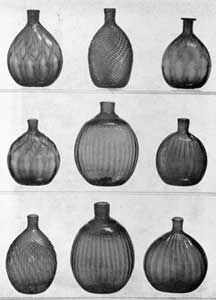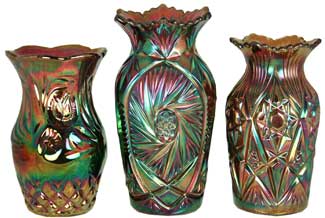Antique and Vintage Glassware

These People Love to Collect Radioactive Glass. Are They Nuts?
By Ben Marks — For many glass collectors, the only color that matters is Vaseline. That's the catch-all word describing pressed, pattern, and blown glass in shades ranging from canary yellow to avocado green. Vaseline glass gets its oddly urinous color from radioactive uranium, which causes it to glow under a black light. Everyone who collects Vaseline glass knows it's got uranium in it, which means everyone who comes in contact with Vaseline glass understands they're being irradiated. It doesn’t matter...

Baron Stiegel, Ironmaster and Glassmaker
By Harold Donaldson Eberlein and Cortlandt Van Dyke Hubbard — The average collector is apt to think of Stiegel only in connection with his glass and the apocryphal stories about him. Bar-iron, pots, kettles and cast-iron apparatus for sugar-refining, window-panes, common bottles and cast-iron stove plates and stoves, even when decorated, do not appeal to the imagination like fine flip-glasses embellished with etched or enamelled devices, wine-glasses of graceful contour, or sugar bowls and cream-pitchers of deep toned blue. Iron is a cumbersome...

American Historical Glass Cup Plates
By Ruth Webb Lee — Over the years since collecting cup plates became a diverting hobby, it was natural that they should have become classified into two groups, known today as "historicals" and "conventionals." The historicals are, for the most part, those which commemorate famous persons or historical events. "Conventionals" present an evolution of design — from the simple geometrical patterns of the early days, through the beautiful but sophisticated lacy glass patterns onward to their end in the Gothic...

The Miles Collection of American Glass
By Joan S. Wilson — The sweeping tendency to dismiss all American glass manufactured after 1850 as a cheap commercial product is passing out of fashion. Articles and books on the subject are partially responsible for the change of opinion but the real explanation is that much of this glass has won the esteem of discriminating collectors. There are numerous collections which support this conclusion, one of the finest just having been placed on exhibition in the American Wing of the Metropolitan Museum of...

Atterbury Designs for Covered Animal Dishes in Glass
By Ruth Webb Lee — While doing research work in the Pittsburgh, Pennsylvania, area in 1933, it was my privilege to interview a large number of officials connected with glass companies, as well as actual glassworkers. It was disappointing to find that most of the officers were primarily interested in what they could make money on tomorrow, rather than in the products their grandfathers or the former heads of their concerns manufactured. They cannot be blamed for their attitude, even though it was disheartening...

English Royalty in Glass
By Richmond Huntley — "All the discourse now-a-day," wrote Samuel Pepys in the spring of 1660, "is that the King will come again; and for all I see, it is the wishes of all; the soldiers at Dunkirk do drink his health in the streets. Great joy at London and ringing of bells, and drinking of the King's health upon their knees in the streets, which methinks is a little too much. But everybody seems to be very joyfull in the business." The years of the Commonwealth were at an end, leaving an England...

The Similarity Between Ancient and Early American Glass
By Marshall Davidson — At this moment of writing Egypt's most recent plague, under General Rommel, threatens Alexandria. The strategic value of his immediate objective, as a stepping stone to the East and as the sole adequate harbor remaining to the British Mediterranean fleet, is a matter of daily comment in the press. But the ancient city has tempted ambitious men for more varied reasons over the course of years. In other days it served as the entrepôt for the harvests of Egyptian grain; it harbored the...

Miniature American Blown Molded Glass
By Ruth Webb Lee — Before treating in detail of the miniature or toy pieces of Blown Molded, or as it still known, "blown three-mold" glass, it might be well to become better acquainted with the forerunner of this popular type of early glass. Miniatures have a wide appeal to all collectors, irrespective of their particular specialty. Its size has the charm that inheres in baby things. The earliest advertisements of our glass companies invariably refer to their "molded" glass, meaning that type of glass...

Blown Molded Glass of New England
By Ruth Webb Lee — The American glass collection formed by the late William T. H. Howe of Cincinnati must be counted among the most outstanding in general interest of any ever assembled in this country. When Part I of this collection was dispersed last November, it was an event of national importance for glass collectors. The leading collections, both private and those in museums, were represented at the two sessions of this sale. Now, in Part II, the balance of the Howe collection will be sold on the...

Ohio and Midwestern Glass
By George S. McKearin — Among collectors, the blown glass which was made at the early glasshouses of Ohio and the Midwestern district has long been highly regarded. The craftsmen working there seem not only to have followed the Stiegel technique but to have developed and even created forms, colors, and elaboration of pattern-molded designs that were distinctly American. This is well illustrated in the beautiful swirl design, so frequently with a delicate feathery effect, produced from part-sized, vertically ribbed...

Glass But Too Late
By Ruth Webb Lee — On a cycle as constant as the seven-year locust, though more frequent, magazines devoted to fashions and the home have published articles on taste in interior decoration — good and bad. The illustrations picture a room cluttered with "horribilia" and, for comparison, the same room treated with furniture and accessories that impart charm and a sense of repose. Or another article, by before and after photographs, shows how, with some alterations and fewer dollars, a plain unattractive...

The Iridescent Charms of Carnival Glass
By Maribeth Keane — Our newest book is actually the fully revised and expanded second edition of our first book. It came out originally in 1997, but needed a lot of updating because we’d done so much research since we wrote it. There was such a huge amount that needed to be brought up to date, so the publisher, Schiffer, allowed us to revise and expand it. We do a lot of cutting edge research into Carnival Glass – things people haven’t discovered or written about before. There are more photos, more writing, and...

American Cut Glass, From Flint to Brilliant
By Maribeth Keane — I started collecting cut glass when I was about 18. My sisters were married, and during the summer, I would go out and stay with them in the Midwest and work. That was back in the late ’70s when you could go to flea markets and you could find wonderful things. Every weekend I would go antiquing with both my sisters, and at the end of the summer, after working, I had some extra money. I decided I was going to buy myself a piece of cut glass. The finest cut glass was made by American...

The Colors and Forms of Early American Pattern Glass
By Maribeth Keane — My mother was our inspiration for collecting pattern glass. She collected it, and she died at a very young age. My sister and I inherited it and my aunt said not to sell anything until we were older. She had some good stuff. My sister called me one day telling me she found a goblet in the pattern that mother had, so I decided to look. The first pieces we found were some wine glasses. Once you find a treasure, it’s what gets you started. You figure out that you can identify something of value...